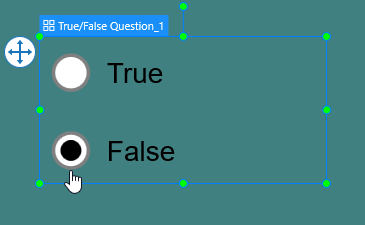True/False questions are factual-based questions. This question type is widely used to test learners’ ability to identify the accuracy of facts, statistics, principles, or other information.
A True/False question often consists of a statement and only two answer options, in which True – False are the most recognizable ones. However, there are also variations for these options, for example, Right – Wrong, Correct – Incorrect, Yes – No, I Agree – I Disagree, etc.
In ActivePresenter 8, True/False is the first question type that you can see in the Questions tab:

This tutorial will show you how to create a True/False question through 6 stages:
- Insert a True/False Question
- Customize a True/False Question
- Set Correct Answer
- Set Score and Reporting
- Add Events – Actions
- Customize Feedback Layers
Let’s start right now!
Insert a True/False Question
To insert a True/False question, do either of the following:
- In the Questions tab > True/False
- In the Home tab > Interactions > True/False
Then, you will see a new question slide inserted into your project as in the below image:

As you can see, a True/False question slide has three parts:
- (1) the top text box to the add question title;
- (2) the answer area with two default answer options: True – False;
- (3) and the Submit button.
Customize a True/False Question
As discussed at the beginning of this article, a True/False question always has two answer options because of its nature. Therefore, you can neither remove nor add more answer options to this question type.
Except for that, you can customize a True/False question in the same way you do with other question types in ActivePresenter. In detail, you can:
- Change the container layout: To change the question layout, access the Properties pane > Size & Properties tab > Container Layout. In this section, ActivePresenter 8 offers you three options: None, Flex, or Grid. Select the layout mode that you want. Then, you can customize its properties.

See Container Layouts of Questions for more details.
- Resize the question title (1) and the answer area (2): You can resize these sections by selecting them and dragging the resizing handles. Or, select them, then go to the Properties pane > Size & Properties tab > Transform to adjust or type the value in the Width and Height combo box:

- Edit radio button: Each answer option comes with a radio button. Freely format this button by selecting the answer area then accessing the Format tab. Here, you can select the radio style that you like or customize it as you wish.

See Work with Check Boxes and Radio Buttons for further information.
- Edit/ Add text to answer options: By default, you can see that answer options are named True – False. However, you’re free to rename them. For example, you can change the text to Yes – No, Correct – Incorrect, Right – Wrong, or whatever you want.
Tip: After customizing the question, right-click the answer area and select Set as Default True/False Question if you want to reuse it. By doing this way, the next time when you insert a new True/False question, this default question will appear.
Set Correct Answer for True/False Questions
Double-click the radio button that corresponds to the correct answer option to denote that it is the correct answer:

Set Score and Reporting
To set score and reporting for a True/False question, select the answer area of the question. Then, go to the Properties pane > Interactivity tab > Score & Reporting.

This section provides a lot of useful options to:
- (4) measure learners performance (select the Graded mode) or collect learners feedback or information (select the Survey mode);
- (5) track learners results;
- (6) mix up answer options when the question is presented to learners;
- (7) set points for correct answers;
- (8) set the maximum attempts that learners can interact with the question;
- (9) set a time limit which only allows learners to respond to the question in the given period of time.
For more details, see How to Create Interactive Quizzes.
Add Events and Actions
ActivePresenter offers default events and actions for True/False questions. Generally, a True/False question has four default events for the Graded mode (On Correct, On Incorrect, On Incomplete, and On Timeout) and three for the Survey mode (On Complete, On Incomplete, and On Timeout).
If you’ve selected the Graded mode, here what you’ll see:

You can remove, change, or make events and actions for True/False questions more advanced as you wish. To do that, first, select the answer area. Then, access the Properties pane > Interactivity tab > Events – Actions.
See Work with Events – Actions to learn more.
Customize Feedback Layers
ActivePresenter automatically adds default feedback layers for True/ False questions. These default feedback layers can be Correct Feedback, Incorrect Feedback, Try Again Feedback, Incomplete Feedback, and Timeout Feedback (for the Graded mode) or Complete Feedback, Incomplete Feedback, and Timeout Feedback (for the Survey mode). Bear in mind that you can delete, change, or add more if necessary.
See Use Feedback Layers to get more details.
Now, you’ve learnt how to use True/False questions in ActivePresenter 8. Download the app right now and start creating fun interactive quizzes.
Visit the following links if you want to know more about how to work with other types of questions in ActivePresenter: